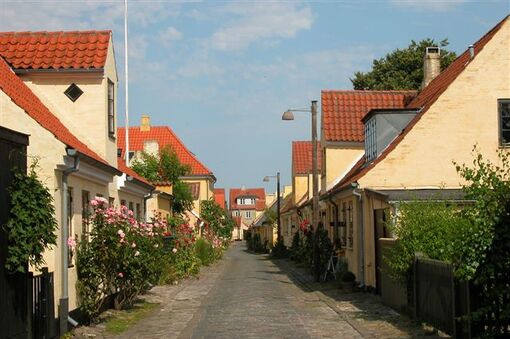
Marianne & Mark
Marianne & Mark
About Dragoer
Pronunciation
Americans, for proper pronunciation of the town, please follow the link:
http://forvo.com/word/drag%C3%B8r/
A little history of Dragør and the area
The wedding will be in a small town called Dragør about 7.5 miles from the city center of Copenhagen.
Dragør is located on Amager, which is an island. Some parts of Amager are part of Copenhagen as well. Amager is also where Copenhagen Airport is located. Dragør is placed on the southern part of Amager. It's a charming little town with old, crooked, yellow houses and narrow cobblestone streets.
In the 1300s and 1400s Dragør was an international marketplace for Hanseatic merchants. They main commodity was salted, dried herring. The herring sales ended in the middle of the 15th century and the area was not inhabited until Dutch settlers settled in the old town in the beginning of the 17th century. In 1658 Denmark lost Scania, today known as the southern part of Sweden, to Sweden. Some Danes living in Scania at this time were not happy about becoming Swedes, so they decided to move across the waters. Most of them settled in Dragør.
Dragør quickly evolved into a thriving shipping town and today the town still shows sign of its past glory. The habor is still the pivotal point of the town as well as an important part of the "old town experience". From the harbor there's a great view over the tidal meadows and over the old town.
Dragør Badehotel is also visible from the harbor area. The hotel was founded in 1907, when the railway from Copenhagen was established. The hotel was part of a trend starting in the late 19th century and continuing all the way up to the mid-20th century: The Badehotel Trend. Badehotels or seaside hotels popped up everywhere in the country and were popular amongst the wealthier townspeople. In the summer they would travel out to the seaside to get a change of scenery, some fresh air and some sun.
Dragør Badehotel is a small, charming bed-and-breakfast style hotel where visitors can still experience the special "badehotel" atmosphere.

Lidt historie om Dragør og området
Dragør ligger på Amager ca. 12 km fra Københavns bymidte. Det er en idyllisk lille by med gamle, skæve, gulmalede huse og brostensbelagte gader.
Dragør var i 1300- og 1400-tallet international markedsplads for hanseatiske købmænd, der rejste til byen for at købe nedsaltede sild. Handlen ophørte i midten af det 15. århundrede og først i 1600-tallet, hvor hollændere bosatte sig i området, var byen igen beboet. Også en del skåninger bosatte sig i Dragør, efter Danmarks tab af Skåne til Sverige i 1658.
Dragør udviklede sig til en driftig søfartsby og det bærer byen stadig præg af. Havnen stadig byens omdrejningspunkt og er en væsentlig del af oplevelsen af Dragørs gamle bydel. Fra den nye lystbådehavn ved Dragørfortet er der et flot kig ned over strandengene og ind over byen.
Herfra kan man også se Dragør Badehotel. Hotellet blev grundlagt i 1907, da jernbaneforbindelsen til fiskerlejet blev oprettet. Jernbaneforbindelsen gjorde det let for landliggere fra København at komme til Dragør og byen blev et populært rejsemål.
Dragør Badehotel er et lille hyggeligt hotel hvor den helt specielle badehotelscharme er velbevaret.
Speaches and Toastmaster
Speaches
Marianne's sister Kirsten is going to be toastmaster at the wedding.
If you wish to speak at our wedding please let Kirsten know at least a few days in advance. She can be contacted via e-mail at barner55@yahoo.dk.
We welcome anyone to speak, but please keep it short. We don't want to be stuck at the tables all night. We also want lots of time to dance!
Also please keep in mind that this wedding is a bilingual event. Some might not know too much English, some might not know much Danish.
Taler
Mariannes søster Kirsten er festens toastmaster.
Hvis du ønsker at tale til vores bryllup, vær sød at give Kirsten besked mindst et par dage i forvejen. Hun kan kontaktes via email på barner55@yahoo.dk.
Alle skal være velkomne til at tale, men fat jer venligst i korthed. Vi vil ikke sidde ved bordene hele aftenen, vi vil også danse!
Husk desuden på, at brylluppet er en tosproget begivenhed. Nogle forstår ikke meget engelsk, andre forstår ikke meget dansk.